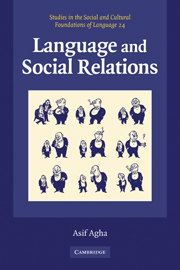Book contents
- Frontmatter
- Contents
- List of figures
- List of tables
- Acknowledgments
- Typographical conventions
- Introduction
- 1 Reflexivity
- 2 From referring to registers
- 3 Register formations
- 4 The social life of cultural value
- 5 Regrouping identity
- 6 Registers of person deixis
- 7 Honorific registers
- 8 Norm and trope in kinship behavior
- Notes
- References
- Index
- STUDIES IN THE SOCIAL AND CULTURAL FOUNDATIONS OF LANGUAGE
5 - Regrouping identity
Published online by Cambridge University Press: 05 September 2012
- Frontmatter
- Contents
- List of figures
- List of tables
- Acknowledgments
- Typographical conventions
- Introduction
- 1 Reflexivity
- 2 From referring to registers
- 3 Register formations
- 4 The social life of cultural value
- 5 Regrouping identity
- 6 Registers of person deixis
- 7 Honorific registers
- 8 Norm and trope in kinship behavior
- Notes
- References
- Index
- STUDIES IN THE SOCIAL AND CULTURAL FOUNDATIONS OF LANGUAGE
Summary
Introduction
In the last chapter we took a close look at accent as an emblem of social identity. We saw that British RP comes to be constituted as an emblem by the connection (established by metasemiotic discourses and practices) between social personae and phonological facts of sound, a connection that treats the latter as diacritics of the former. We saw that over the historical envelope of its existence the emblem changes (both in its sound and persona aspect) through the metasemiotic activities of social actors; and that at any given historical stage, the positional acquaintance of social actors with this emblem makes certain identity readings determinate from facts of utterance. Our goal now is to consider emblems whose diacritics are perceivable signs of any kind (not just utterances) and to ask how determinate readings of social identity emerge through their enactment and deployment in conduct.
The main goal of this chapter is to show that a person's social identity, or identities, become determinate only through a class of semiotic processes whereby images of personhood are coupled to or decoupled from publicly perceivable signs. Some among these are images to which persons form attachments, or lay claim, seeking to make them their own; yet the range of images of self construable by others is invariably larger as a matter of principle. In the case of self-images to which persons do form attachments, a person's ‘identity’ is sometimes linked to a psychobiographical self-conception.
- Type
- Chapter
- Information
- Language and Social Relations , pp. 233 - 277Publisher: Cambridge University PressPrint publication year: 2006

